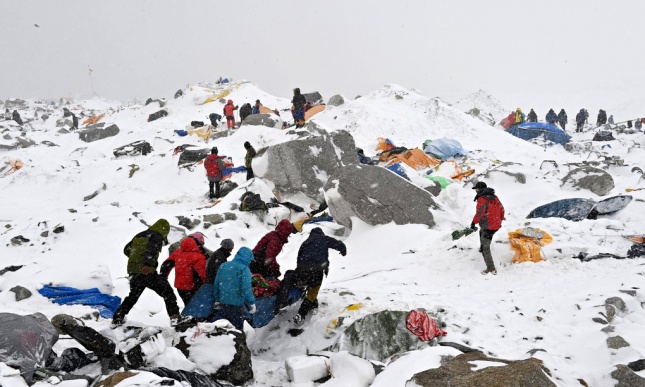Rachel Tullet suffered serious injuries to her leg but helped keep climbers and Sherpas alive until help arrived

Survivors of the avalanche at Everest base camp have been describing how a British doctor who was caught up in it helped save the lives of 23 critically injured people, despite being wounded herself. She later stitched up her own leg without anaesthetic.
When the avalanche triggered by the 7.9-magnitude Nepalese earthquake struck, Dr Rachel Tullet, 34, from Cranbrook in Kent, was swept on to a rock and buried under a layer of ice crystals for several minutes. She said: “I realised I’d injured my leg, but I was just amazed that I’d survived it. And in the scale of what happened to other people, it just didn’t even register.”
She immediately sprang into action and led an operation that helped keep 25 seriously injured people – 19 Nepalese and six foreign climbers – alive until they were evacuated by helicopter nearly 24 hours later. Two later died of their injuries in Kathmandu.
David Hamilton, expedition leader of the Jagged Globe team, whose camp was in the middle of the avalanche’s path, said: “What she didn’t tell anyone is that she had actually injured her leg quite badly. She’d torn her ligaments, cracked her patella, and had a gaping wound in the middle of her leg, which she went on to stitch up herself the next day without anaesthetic.”
Details of the role she played emerged as the Foreign Office confirmed the death of backpacker Matthew Carapiet, 23, an architecture student from Bearsted, Kent, who was trekking in Langtang Valley when the earthquake struck. His family said “he made a huge impression on the lives of everyone he met”.
Tullet, who now lives in New Zealand, is a specialist in emergency and wilderness medicine and had come as a volunteer to work in Everest ER, the medical tent at the mountain’s base camp run by the Himalayan Rescue Association. Its mission is to provide paid-for care for the expeditions, with the proceeds being used to provide free medical care for Sherpas. While there has been criticism that the climbers on Everest received priority treatment and access to helicopter evacuation, given the scale of the catastrophe elsewhere, the vast majority of those whose lives were saved were Nepalese Sherpas and support staff.

Selina Dicker, 38, a climber from London who spent the day in the medical tent caring for a team-mate, saw Tullet in action. She said: “She was an absolute superwoman. I’ve no doubt that far more people would have died if she hadn’t been there. She said that she had been caught in the avalanche, but she never once gave away that she was injured.
“She organised the whole thing, kept completely calm in this frankly crazy situation, and that was on top of treating all the patients – at one point she must have had 30 people on stretchers – as well as certifying the dead and organising all the patients to be carried down to another camp. She’s incredibly self-effacing, though, so she’ll probably never admit to it.”
She certainly is. When contacted by the Observer, Tullet said it had been a case of “extraordinary teamwork which saw everybody come together in a quite unbelievable way”, and she paid credit to her colleague, Megan Walmsley, an Australian anaesthetist, who had done “a brilliant job”, and the leaders of the expeditions who had helped support the medical team.
She is in New Zealand recovering, but is planning to return to Nepal in a fortnight. “I went through the [2011] Christchurch earthquake [working in A&E] so I just feel so sad for Nepal. It’s such a long recovery process, and that’s in a developed country, so I just want to come back to try to provide what help I can.”
She said that she and Walmsley had been up all night with a patient suffering from cerebral oedema when the avalanche struck. “Megan stayed with the patient and I ran outside because we heard an avalanche and I was concerned that it was going to hit climbers on the [Khumbu] icefall as it did last year [when 16 Sherpas died].
“I ran partly up a slope but couldn’t see it, and then I looked in the opposite direction and I saw a giant wave. It looked like a tsunami. My first thought was that this could kill me. And my next thought was, ‘Well, I did choose to be here.’” The severity of the injuries was, she said, “consistent with a bomb blast” – severe head trauma and internal injuries – but one of the most difficult things to cope with was that she knew so many of those who were killed and injured.
Michele Battelli, an Italian climber who works for Google and whose best friend, Dan Fredinburg, was one of those killed, said that he saw her “come stumbling out … she was limping. She staggered out and I shouted at her and she came over and examined Dan, and then she just leaned over and kissed him on the forehead and said, ‘He’s gone.’”
